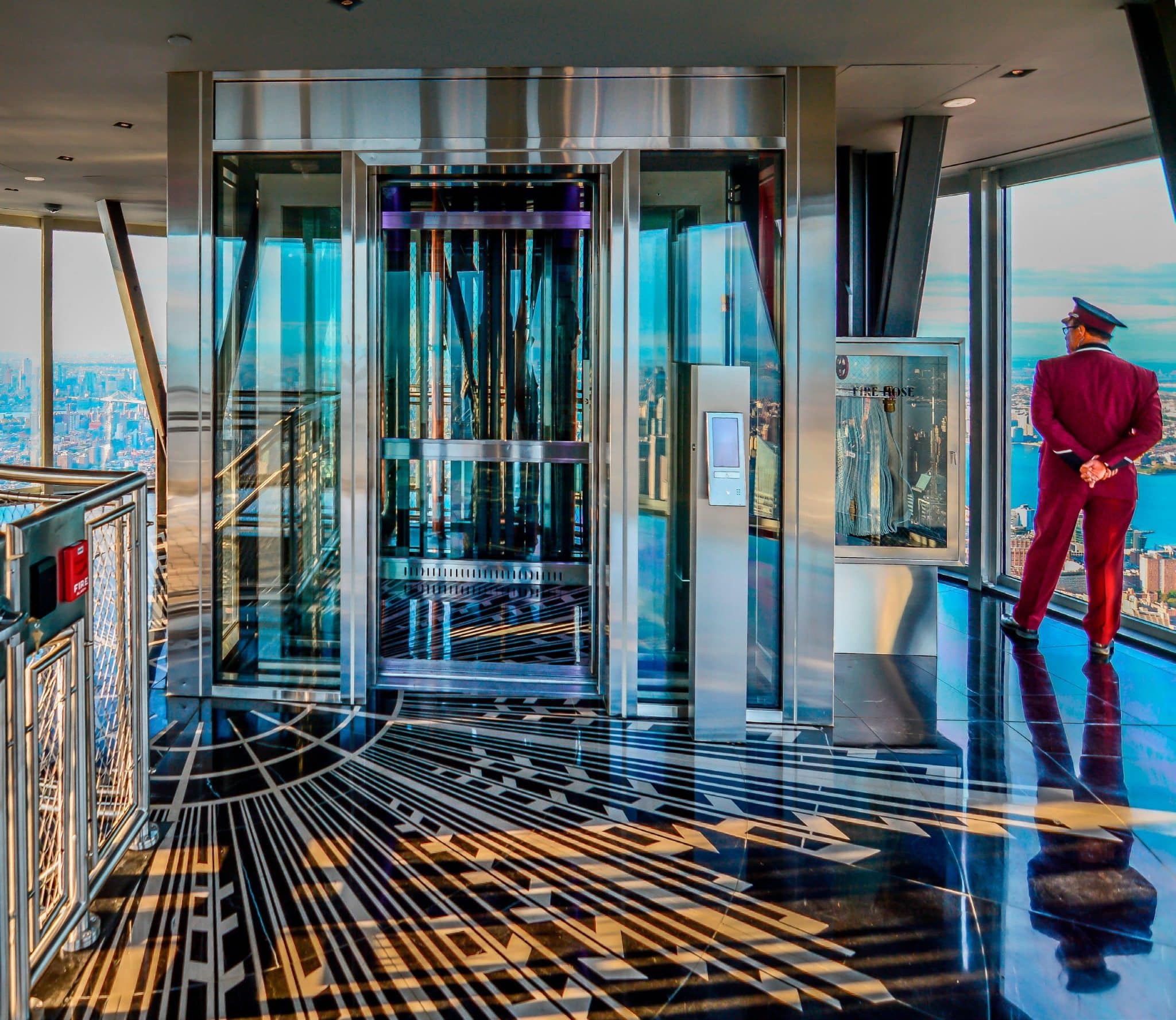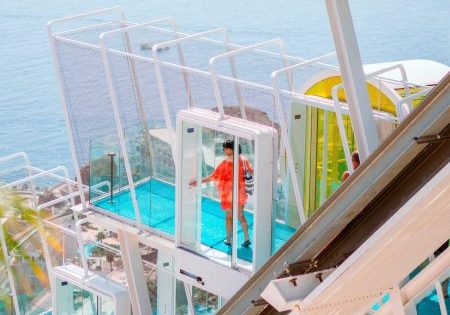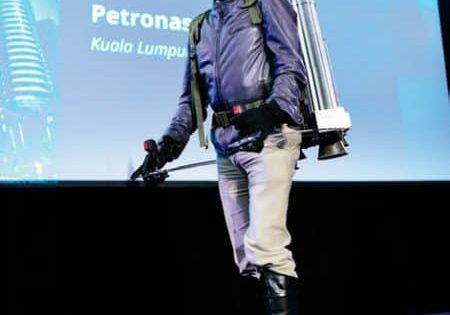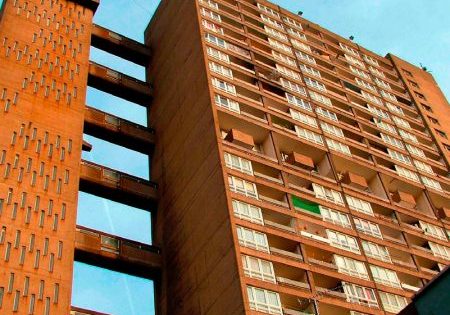Otis is chosen again for a showcase elevator (and more) in the iconic skyscraper.
submitted by Katy Padgett, Otis
In 1931, Otis delivered the groundbreaking elevator system technology that made ascending the (at the time) record- breaking height of the Empire State Building doable in minutes. Eighty years later, Empire State Realty Trust bestowed Otis with the contract for the system’s modernization, which is among the largest and most complex modernization projects in Otis’ 165-year history.
The modernization, which began in 2011 and ended in October 2019, encompassed the original 68 elevators throughout the building. The project is literally topped of by a new, one-of-a-kind, custom Gen2™ glass elevator and glass hoistway, which replace the existing elevator to the mast. The car travels from the 86th foor to the landmark building’s newly renovated 102nd-foor observatory.
Advanced Technology
Otis’ mission was to create a unique and exciting experience for visitors to the world’s most famous building, while improving the elevators’ energy efciency and moving more people through the building faster. The modernization aimed to save time and energy, and boost overall efciency. During peak travel periods, the Otis CompassPlus® intelligent dispatching technology helps passengers get to their destinations 50% faster than the original system.
With the Otis ReGen™ regenerative drive, the Gen2 elevators use about 75% less energy under normal operating conditions compared to that of conventional systems without regenerative technology. Furthermore, regenerated energy can be placed back into the building’s power grid to be utilized elsewhere.
The modernized elevators also include design changes like efcient permanent- magnet (PM) gearless machines; LED lighting with an energy-saving sleep mode; and system optimization, and fan and lighting controls that enhance efciency. The custom elevator travels in a glass-walled hoistway, treating passengers to an entertaining ride that ends with a 360° view of the city from the reimagined glass- enclosed observatory. The glass mast car is fully customized, featuring lights synchronized to music and illuminating colored graphics on the hoistway wall that appear as the elevator ascends.
Transportation System Details
Otis’ involvement with the Empire State Building dates to the landmark’s construction. Otis designed and installed the most technologically advanced elevators in the world at the time. In April 1931, an article in Popular Science read:
“Governed by complex electrical brains, through miles of copper-wire nerves, this feet of automatic elevators is expected to handle an unprecedented trafc with a smoothness, swiftness and safety that could not be approached under ordinary human control.”
The elevators were capable of moving people and materials through the world’s frst 100-plus-story building faster, safer and with more reliability than ever before. While the installation was the most complex challenge ever presented to the company, it met the landmark’s needs. Otis was selected in 2011 (the building’s 80th anniversary year) to take on the job with an unchanged mission — to create a memorable experience for the nearly 10 million annual visitors.
Just as it did in its original installation, Otis featured its most innovative products to achieve peak performance, efciency and ride quality. The building’s owner, Empire State Realty Trust, began undergoing a series of retrofts and other renovations in 2009 to reduce energy consumption and reimagine the building for visitors and tenants alike. To ensure the elevator modernization complemented that goal, Otis instituted design improvements to make its latest products more efcient. The Gen2 modernization system for the glass observatory elevator has new 30- and 40-T PM gearless AC machines (replacing DC models); REM™ (Remote Elevator Monitoring), which allows for managing the system from a computer; new 411HS controllers; Glide P System door operators; new counterweight frames and safeties; and new car slings, platforms and cars, covering two banks of elevators totaling 18 units. Additionally, new car interiors replicate the historical look of the existing units.
The Gen2 elevator features patented polyurethane-coated steel belts that last twice as long as conventional steel ropes, without lubrication, and a PM gearless machine that is 80% smaller than conventional machines. Mounted on rubber isolation pads, the low-noise gearless machine reduces vibration and minimizes noise in adjacent rooms. In addition, high-performance door operators allow passengers to enter and exit elevators more quickly, and robust wiring ensures reliable communication throughout the system. CompassPlus, installed on the building’s 58 passenger elevators, is customized for the building’s design, trafc and security needs. It enables passengers to get to their destinations 50% faster during peak travel periods (rush hours) than the original system.
On the 102nd-foor landing, even the top part of the Gen2 glass elevator’s hoistway walls are glass, giving the passenger the feeling of being in a glass dome at the top of the world. However, the visitor experience begins on the second foor in the elevators that rise to the 80th: those cabs feature “disappearing ceilings” on which a video experience timed to end upon arrival is projected.
Removal, Installation and Challenges
Over the 14 months of construction on the Empire State Building, beginning in 1930, timing of each task had to be perfect, and Otis’ elevators played a crucial role in moving workers and material throughout the building with few delays.
To keep things moving and on time as the building rose by some four-and-a-half foors per week, temporary elevators were used and moved up every two days. More than 80 years later, Otis had the challenging task of completing the modernization, while providing elevator service for tenants, visitors and tourists in a fully functional ofce building that happens to be one of the world’s most popular tourist attractions. Other challenges added to the task.
An early, and major, challenge was removing existing machines and other equipment from the building and moving new equipment into place. The requirement to utilize service elevators for these activities meant that material coming in and out of the building had to be transferred from elevator bank to elevator bank. In the case of delivering new counterweight frames to the basement, this meant traveling up one set of elevators to the 68th foor before the equipment was transferred to another set of elevators for the journey down to its destination.
Removing the original elevator machines, some weighing as much as 26,000 lb apiece, was also a signifcant test since they were too large and heavy to remove intact. As a result, each was manually cut into manageable sizes to be placed on elevators and removed. Due to safety requirements, no cutting torches could be used. While the new machines being installed were generally smaller than the existing ones, bringing them onsite presented similar challenges. To address these, the machines were disassembled before delivery and brought by elevators in manageable pieces and sections to be reassembled at each installation site. With a location in the heart of Manhattan, a lot of coordination and planning was necessary to manage and store the signifcant amount of material and supplies necessary to keep work fowing.
Major challenges occurred in maintaining, replacing and, in some cases, adapting original equipment and technology that had been upgraded over the years. Newly engineered duplex counterweight safeties had to be custom-made to ft in the existing frames and hoistways, and custom rigs were developed to lower new counterweights in place. Maintaining and keeping obsolete equipment during the transition presented another challenge, as parts no longer in production often had to be fabricated.
While most foors featured more typical, center-opening elevator doors, engineering solutions combining new and previous-generation technology developed swing doors, which open like doors typically found in room construction. The modernization of the observatory-level elevator exhibited further hurdles with custom swing doors and center-opening integration, as well as relocation of the counterweight rails. It also required custom compass fxtures and operation for observatory trafc. Other challenges involved hard deadlines to open the elevator to observatory visitors, though work was already going 24/7. Additionally, once the original observatory unit was taken out of service, those working on the new elevator had to walk the stairs, because no other elevator serves the top of the building.
The switchover from the old elevators to the new ones during and after construction required an intricate scheduling matrix. Typically, one or two elevators in several banks would come ofine at a time to be modernized. In addition, during the transition, dispatching utilized both the existing and new systems. Regardless, the goal remained to provide seamless and satisfed customer ride experiences, regardless of ongoing work.
Maintenance
At the same time the modernization contract was awarded, Otis received a 10-year maintenance contract. Performing system maintenance and service during this time allowed Otis to ensure the safe and smooth operation of the building’s elevators and escalators during the multifaceted modernization process. Otis feld professionals are onsite 24/7 making sure all equipment is operating at peak performance. These Empire State Building-based employees are among 33,000 Otis feld professionals who are the heart of the company and the daily touchpoint for customers around the world.
Conclusion
Otis is proud of its work on this historic elevator modernization that combined the best of the old and the new. Urbanization is creating new demand for moving people seamlessly through an increasingly connected urban world. Likewise, today’s Otis elevators in the Empire State Building transport 10 million tenants, visitors and observatory guests each year. These elevators play an integral role in nearly every visit, transporting passengers efciently and safely from the ground foor to the observation deck and every foor between.
Credits
Owner: Empire State Realty Trust
Developer: Jones Lang LaSalle
Consultant: BOCA Group
Architect: Beyer Blinder Belle
Elevator services provider, equipment manufacturer and component supplier: Otis
Get more of Elevator World. Sign up for our free e-newsletter.









